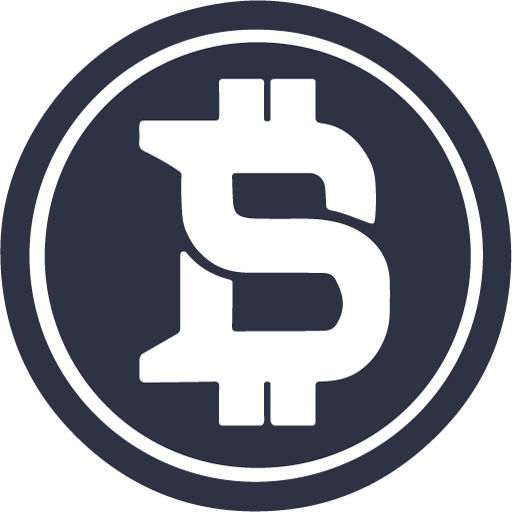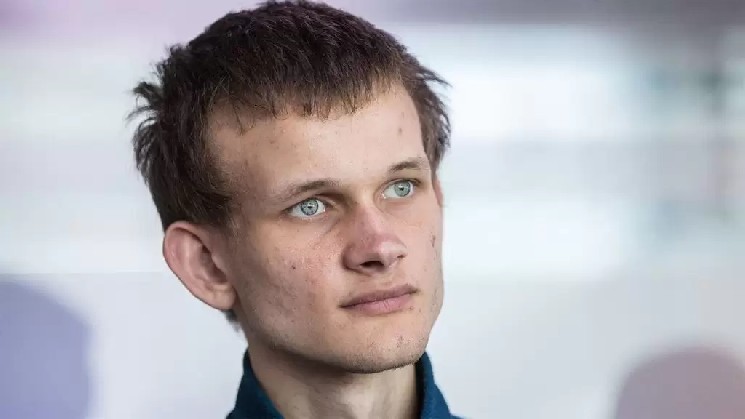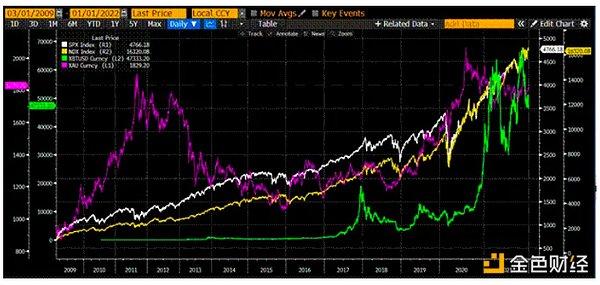Author: David Hoffman, Bankless; Compiled by Bai Shui, Jinse Finance
MEME coins have sparked intense discussion.
Some see them as degenerate distractions - inefficient, zero-sum games at the expense of others' interests. Others view them as a grassroots reaction against the top-down influence of elites and venture capitalists.
We're all familiar with this debate - the industry has had this dialogue countless times. Yet, like many aspects of crypto, the arc of MEME coins is dynamic, adaptive, not inert.
We have reason to be optimistic about the future of MEME coins.
The term "MEME coin" has been overused and overly broad. Not all tokens labeled as MEME coins fit the stereotypical mold of hollow, inert gimmickry. Some tokens started as MEME coins but have since evolved into something more, but due to inertia, people still end up slapping the MEME coin label on them.
Platforms like Pump.fun have enabled the creation of tokens, the increase in token supply, and democratization. Of course, with the low barrier to entry, most of these tokens are easily created - a fun name, a quirky image - meant to entertain and little else. Yet, amidst the noise, some MEME have unexpectedly gained substantive content and driven value.
Pump.fun, Clanker, and token launchpads have made creating liquid tokens incredibly easy. Permissionless and accessibility are core value propositions of our industry.
More Accessible
The trajectory of the crypto industry has been to increase the accessibility of token creation for the average person.
The history of cryptocurrencies is in part a history of continually increasing the accessibility of token creation. Each bull market has brought new mechanisms:
2013: People realized it wasn't hard to fork Bitcoin's codebase and create new blockchains.
2017: Ethereum introduced ERC-20 tokens, allowing token creation without launching a full blockchain.
2021: Non-Fungible Tokens (NFTs) and minting mechanisms unlocked another token standard and distribution mechanism, turning quirky images into speculative assets.
2024: Pump.fun combines token minting and AMM liquidity, all packaged into a simple interface.
This pattern extends beyond tokens. Why are there so many L2s? Because Optimism's OP stack lowered the cost of creating rollups. Conduit takes it further by creating the frontend for L2 creation.
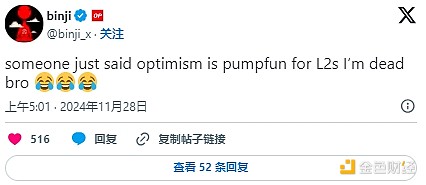
The latest innovation in token creation is Clanker, an LLM Warpcast account where Warpcast users can simply tag Clanker with a stock ticker and an image, and Clanker will automatically mint a token and bootstrap a Uniswap V3 pool, skipping the frontend entirely.
Beyond MEME Coins
Critics often conflate the token launchpads like Pump.fun or Clanker with the tokens they produce. While many of the tokens that appear on these platforms are classic MEME coins, the launchpads themselves are neutral tools.
For example:
GOAT is a token associated with the first AI agent, coming from Pump.fun. For those wanting exposure to the Truth Terminal IP, GOAT is now an effective investment. Does it have cash flows? No. Is there a direct connection between GOAT and Truth Terminal? No, the relationship is tenuous and indirect. Will the token price appreciate as the Truth Terminal brand scales? I don't know, not investment advice, but maybe, and that's why people are buying GOAT.
ANON launched on Clanker, enabling access to anonymous Farcaster accounts. If you have enough ANON tokens, you can anonymously tweet from your Anon Farcaster and Twitter accounts. That's utility.
We should learn to distinguish between tokens and launchpads. Pump.fun is not a MEME coin launchpad. It is a token launchpad. Good launchpads will only make MEME coin issuance easier.
New Creation Mechanics
Let's discuss the benefits of token launchpads. We can moralize about the products they may produce in the future.
In 2023 and 2024, crypto is plagued by high FDV, low float token distribution mechanics.
Airdrop + high FDV low float mechanics are unfortunately a confluence of factors, primarily excess venture capital and the most stringent regulatory environment in crypto history.
The result of this confluence is that airdrop and vampire mechanics have emerged, adopted by complex, extractive airdrop vampire recipients, creating toxic and perverse incentives, faked metrics, and little actual value distributed to target stakeholders.
MEME coins are the antithesis of this token distribution mechanism.
You can be the 7th person to buy a sub-$1M market cap token with 100% of the supply in liquidity.
This token generation mechanic has its merits!
On day one, the entire supply of the token is in the market. That's nice. This eliminates the different classes of locked token investors. Everyone gets the same valuation. Everyone is on the same tier of investor.
Nevertheless, there are still insiders and cabals that may sabotage tokens when creating them through launchpads. Additionally, the principal-agent problem between token creators and token buyers remains unresolved. Fully liquid token issuance does not solve the fundamental human problem. Humans are imperfect and easily corruptible.
Nonetheless, the ability to launch tokens with 100% supply in the market and instant AMM liquidity is a novel and valuable mechanic, with significant upsides, and we shouldn't discard it despite its easy abuse.
We should add it to the toolkit of token creation mechanisms, alongside ICOs and Non-Fungible Token (NFT) mints, as an effective way to bootstrap and distribute tokens.
All Tokens Start as MEME
I encourage people to consider the potential of using platforms like Pump.fun or Clanker to create tokens for your project.
Imagine a founder has a promising idea for a product or service. They believe it has value and plan to work on it long-term to realize its potential. To support their project, they decide to launch a token, either for decentralized governance, managing system risk, collecting fees, or any other possible reason.
This founder could:
Raise funds from venture capitalists
Conduct an Initial Coin Offering (ICO)
Launch a token on a token launchpad
All of these are valid choices, and each founder should consider the merits of each.
Let's specifically consider the last one. Suppose this founder also launches a token early in the project's lifecycle. Maybe because they can, they make the token before working on any other part of the project. If this is the setup, then that token is a MEME. The founder has an idea for a plan, maybe a whitepaper. They share it with others, trying to meme it into other people's minds, but even so, it is still a MEME.
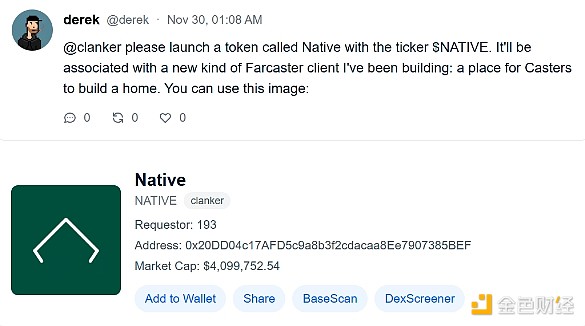
Take the recent Clanker token $NATIVE as an example. This is a token that Derek requested for his Farcaster project, which is clearly to build a new type of Farcaster client.
Maybe the story ends there! Maybe Derek had no intention of actually building Native, he just requested a Clanker token with a 1-tweet-long story about potentially building Native. Maybe Derek has been working on Native for over a year. Who knows! I certainly don't. Derek needs to prove this to the market. But nonetheless, the token has full liquidity, and potential buyers can make their own decisions based on the information they have.
There is certainly a huge principal-agent problem here. Founders can talk about their projects as a means of persuading people to buy the tokens they create, and then they can dump the tokens, which may have been the plan all along.
After writing the above content, Derek tweeted that he had locked the token supply for a year! That guy minted his own tokens, bought his own supply (cheaply), and then chose to tie himself to the mast. Legitimate projects that have gone through legal efforts can emerge from the token launchpad, even if they also primarily launch worthless Meme coins!
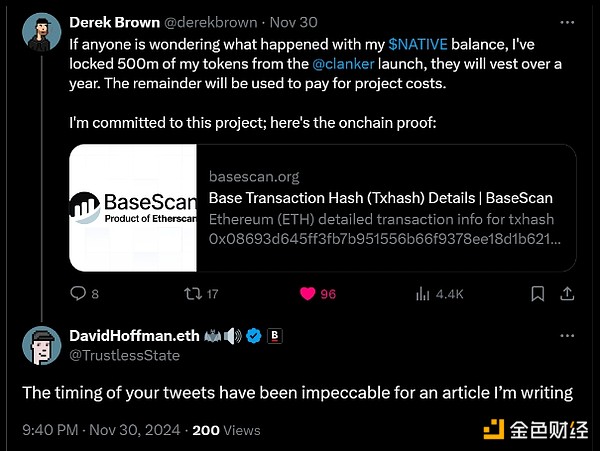
This is what we saw in many of our 2017 ICOs, and the entire industry has also become aware of the idea of VC psychological warfare fabricating stories around worthless projects. Regardless of the token creation mechanism, the principal-agent problem exists. It's just that different groups of people are doing psychological analysis.
Nevertheless, the Pump.fun and Clanker tokens were initially just Memes, and now represent effective efforts to build truly revolutionary things. Again, refer to ANON and GOAT. People just call these Meme coins based on their creation mechanism, but they are not Meme coins!
Improving the Meme Coin Mechanism
When using the token launchpad, there are various ways to improve the principal-agent gap between token developers and token buyers.
What if the developers don't own a portion of the tokens as an upside risk mechanism, but instead have the right to the transaction fee revenue?
This is the mechanism that Flayer is using to build its incoming token launchpad Flaunch. They are building a Uniswap V4 Hook to add some additional features and mechanisms to their token launchpad.
1. Transaction Fee Management
Tokens launched on Flaunch have revenue distribution between developers and the community. Like Pump.fun, Flaunch charges a certain percentage of all transaction fees through its platform. Unlike Pump.fun, Flaunch directly returns these transaction fees to the token developers and token holders (the community).
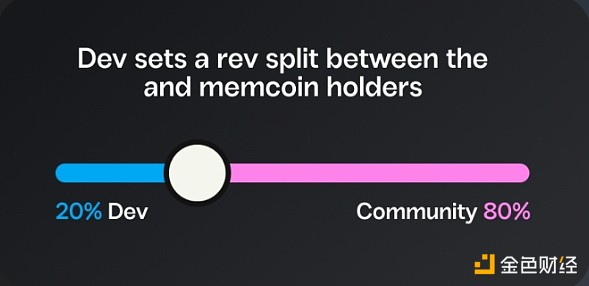
The token developers control the revenue distribution between developers and the community. This is a parameter set at token launch, and can be anywhere between 100% community, 0% developers and 20% community, 80% developers. The community must receive at least 20%.
The fees collected by the token community can be used to buy the tokens and add them to the LP, increasing the price and liquidity of the tokens as trading volume increases. They call this a "progressive buy wall", which is a good narrative. The fees collected by the developers can be used to fund their Lambo, or can be reinvested back into the project to fund development and growth.
This is a more aligned mechanism that helps to narrow the principal-agent gap. Through this mechanism, developers can monetize their transaction fee revenue. They no longer need to sell a certain amount of tokens to fund development. This is highly aligned with NumberGoUp, as transaction fee revenue increases correspondingly as the token price increases.
2. Non-Fungible Token (NFT) Ownership
Who the "developers" of a Flaunch token are is determined by the owner of the NFT. Each token launch on Flaunch comes with a 1/1 NFT, which is the source of the developer's transaction fee revenue.
This NFT becomes a composable object that further structures can be built around. You can put this NFT into a multi-sig and have it managed by a team. Alternatively, the NFT can be managed by DAO token voting, which could be a previously launched token or a new governance token.
The possibilities only expand from here.
So, has my stance on Meme coins changed?
Recently, I've received some criticism on Twitter for apparently pivoting towards Meme coins. Indeed, apart from the occasional Dogecoin pump, I've never expressed support for Meme coins, and have repeatedly stated my preference for productive assets over Meme coins' idleness on Bankless.
I do believe that Dogecoin may represent the best case for Meme coins. Dogecoin is a healthy story of a community gathering under the banner of fun dog pictures and collectively pumping the Dogecoin market cap in good spirits. Additionally, Dogecoin has donated substantial funds to various charities, including clean water projects in Africa, bee conservation work, the American Cancer Society, education, animal welfare, support for the homeless, and of course, my favorite, sending the Jamaican bobsled team to the 2014 Olympics.
Nevertheless, there will still be normal, ordinary, idle Meme coins. These tokens will continue to enrage many, as they are hard to convince anyone that they are not just a speculative PvP internal game, and have an unsustainable principal-agent problem.
My preference for productive assets with a development arc remains unchanged, but my appreciation for the broader potential of Meme coins has expanded.
First, I've started to envision a world where Meme coins play a much larger role in the internet economy than most people currently imagine.
What if the scale of the Meme coin economy grows to rival traditional stock markets? Crypto protocols and markets are designed as supersets of the existing financial system, providing unprecedented flexibility and coverage. Meme coins can leverage this foundation and become a massive economic ecosystem in their own right, powered by their own merits. Listening to the talk of Zoomers and Generation AI makes it clear: Meme is at the core of internet culture, and Meme coins will naturally play a significant role in internet finance.
While Meme coins are currently in a speculative hype cycle similar to ICOs or Non-Fungible Tokens, and may face market shakeouts, they will remain a permanent fixture in the crypto space. The demand for early exposure to new and exciting things will never go away. In this sense, I've started to embrace the long-term potential of Meme coins and shifted my perspective.
Secondly, as shown throughout this piece, I see increasing opportunities for Meme coins to evolve into something greater than the Memes they were born from. Through additional mechanisms, these tokens can transform into "money Lego" that supports more substantive systems. As Meme coins have the potential to develop into more sustainable and productive things, their palatability has also increased for me.
Let's Explore Meme Coins Together
We are people with agency. I choose to believe that we can harness the power of Meme coins, which people clearly enjoy, and build mechanisms that steer Meme coins towards the light, rather than the unsavory.
When Pump.fun added live streaming functionality, it started optimizing for attention and viral spread, and we all know the costs of optimizing for that outcome. When Pump.fun removed the live streaming feature, the platform took an important step away from degeneration and towards health. Through this simple trick, it weakened the incentives for deplorable behavior and created space for more productive outcomes.
I believe there are many more tricks and mechanisms that can continue to improve the nature of Meme coins. The Meme coin industry is massive in scale and will persist. There are vast resources in the Meme coin space waiting to be tapped to create sustainable value.
So, this is a call to startups! Build Meme coin infrastructure, help Meme coins become more valuable. Help solve the principal-agent problem that exists in all token creation events.
Clanker and Pump.fun have produced indestructible Meme coins. These tokens have no backdoors - no one can mint more tokens, and no one can create honeypot traps. These are examples of token infrastructure that helps protect user safety.
There are more mechanisms like these. Let's find them!



